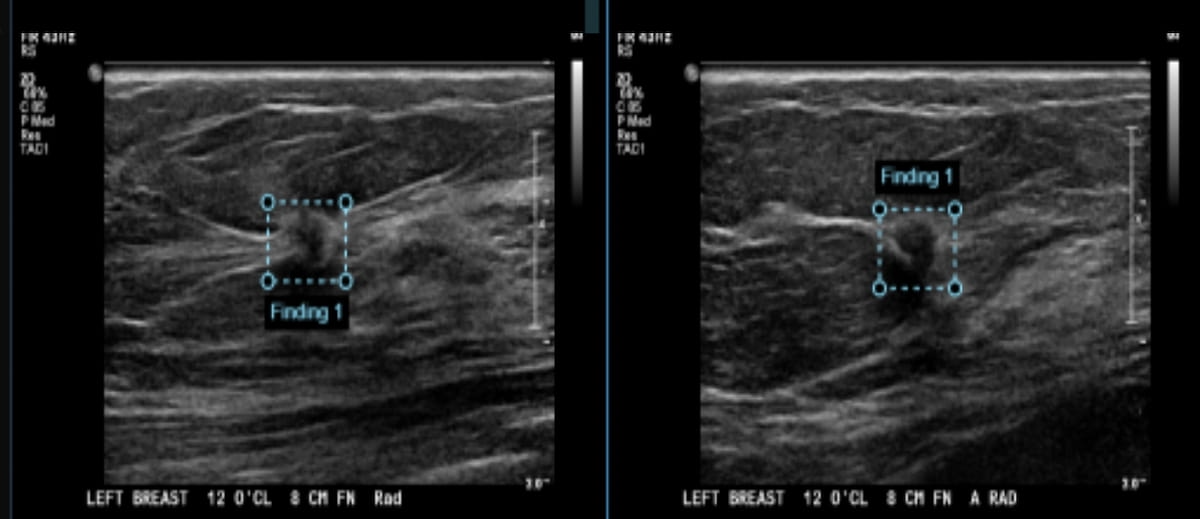New Study Shows Viability of Adjunctive AI for Breast Ultrasound
Adjunctive use of an artificial intelligence (AI) software demonstrated nearly equivalent sensitivity and over 28 percent higher accuracy in comparison to radiologist assessment of breast ultrasound images for breast lesions, according to new research presented at the recent Society of Breast Imaging (SBI) conference.
In new research comparing the use of adjunctive artificial intelligence (AI) to radiologist assessment of breast ultrasound images, researchers found that adjunctive AI had over a 28 percent higher accuracy rate and a nearly 40 percent higher specificity rate for diagnosing breast lesions.
For the retrospective study, presented at the recent Society of Breast Imaging (SBI) conference, researchers assessed the adjunctive use of Koios Decision Support (DS) Breast (Koios Medical) in interpreting breast ultrasound for the diagnosis of breast lesions. The study involved 154 biopsy-proven cases (mean age of 53.2) from a diverse patient population comprised of 33.1 percent White patients, 29.9 percent Hispanic patients, 15.6 percent Black/African American patients, 14 percent Asian patients and 12.3 percent multi-racial patients, according to the study.
The researchers found that use of the Koios DS Breast software had a 60.4 accuracy rate in comparison to a 31.8 percent accuracy rate for radiologist assessment of breast lesions on ultrasound as well as a 97.5 sensitivity rate. There was also a significant reduction of false positives with the AI software (60) in comparison to 105 false positive diagnoses for radiologist assessment without AI.
Images courtesy of the Society of Breast Imaging (SBI).

“Our preliminary results show there is promise that an AI (decision support) system would be an accurate and reliable second opinion in diagnostic ultrasound examinations,” noted lead study author Clara Koo, M.D., a diagnostic radiology resident affiliated with the Mount Sinai Health System in New York, N.Y., and colleagues. “Furthermore, (the AI software) has the potential to reduce false positive readings, especially in younger patients, reducing the burden of unnecessary biopsies.”
In the diverse patient cohort, the researchers also noted no evidence of racial- or machine-based bias affecting the study results. Koo and colleagues added that there was increasing correlation between the AI software and radiologist assessment with advancing patient age.
(Editor’s note: For related content, see “Automated Breast Ultrasound: Is it a Viable Second-Look Option for Women with Dense Breasts?” and “Can Multimodal AI Improve Cancer Detection in Dense Breasts?”)
What is the Best Use of AI in CT Lung Cancer Screening?
April 18th 2025In comparison to radiologist assessment, the use of AI to pre-screen patients with low-dose CT lung cancer screening provided a 12 percent reduction in mean interpretation time with a slight increase in specificity and a slight decrease in the recall rate, according to new research.
The Reading Room: Artificial Intelligence: What RSNA 2020 Offered, and What 2021 Could Bring
December 5th 2020Nina Kottler, M.D., chief medical officer of AI at Radiology Partners, discusses, during RSNA 2020, what new developments the annual meeting provided about these technologies, sessions to access, and what to expect in the coming year.
Can CT-Based AI Radiomics Enhance Prediction of Recurrence-Free Survival for Non-Metastatic ccRCC?
April 14th 2025In comparison to a model based on clinicopathological risk factors, a CT radiomics-based machine learning model offered greater than a 10 percent higher AUC for predicting five-year recurrence-free survival in patients with non-metastatic clear cell renal cell carcinoma (ccRCC).